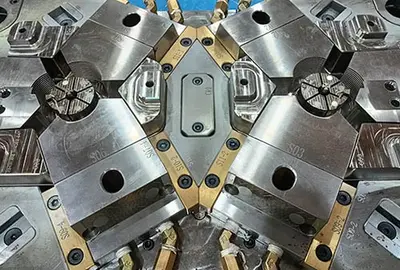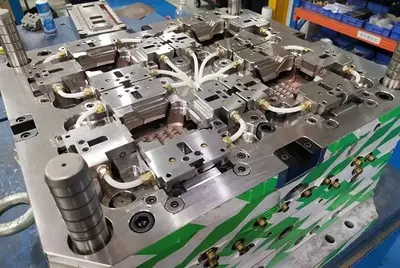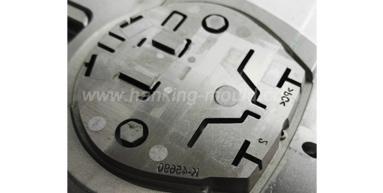

1. The ejector pin of the plastic injection tooling is bent, broken or leaked
The quality of the self-made ejector is better, but the processing cost is too high. Now, standard parts are usually used, and the quality is average. If the gap between the ejector pin and the hole is too large, there will be leakage. However, if the gap is too small, the ejector pin will expand and be stuck due to the increase in mold temperature during injection.
What's more dangerous is that sometimes the ejector pin of the plastic injection tooling is broken due to being pushed out for a certain distance, so that the exposed ejector pin cannot be reset and the concave mold is broken during the next mold closing.
In order to solve this problem, the ejector rod is re-ground, retaining a 10-15mm mating section at the front end of the ejector rod, and grinding the middle part down by 0.2mm. After all ejector rods are assembled, they must be strictly inspected and matched with a clearance generally within 0.05~0.08 mm to ensure that the entire ejector mechanism can advance and retreat freely.
2. Poor cooling of the plastic injection tooling or water leakage in the water channel
The cooling effect of the plastic injection tooling directly affects the quality and production efficiency of the product. For example, poor cooling, large or uneven shrinkage of the product lead to warped surface deformation. On the other hand, the overall or local overheating of the mold makes the mold unable to form normally and stops production; in severe cases, the movable parts such as the ejector pin are thermally stuck and damaged.
The design and processing of the cooling system depend on the shape of the product. Do not omit this system because of complex mold structure or difficult machining. Especially for large and medium-sized molds, the cooling problem must be fully considered.
3. The fixed distance tensioning mechanism of the plastic injection tooling fails
Fixed-distance tensioning mechanisms such as swing hooks and hasps are generally used in fixed core pulling or some plastic injection tooling molds for secondary demoulding. Because this type of mechanism is set in pairs on both sides of the mold, its actions must be synchronized, that is, the buckle is fastened at the same time as the mold is closed, and the hook is released at the same time when the mold is opened to a certain position.
Once the synchronization is lost, the template of the drawn mold will be skewed and damaged. The parts of these mechanisms must have high rigidity and wear resistance, and adjustment is also difficult. The mechanism has a short lifespan, so try to avoid using it, and you can use other mechanisms instead. In the case that the pulling force is relatively small, the method of pushing out the fixed die with a spring can be used. When the core-pulling force is relatively large, the core can be slid when the moving mold moves backward, and the core-pulling action is completed first and then the mold is split. In large plastic injection tooling molds, a hydraulic cylinder can be used for core-pulling.
4. The inclined pin slider core-pulling mechanism of the plastic injection tooling is damaged
The most common problems of this kind of mechanism are that the processing is not in place and the material used is too small. There are two main problems: the inclined pin angle A is large, and the advantage is that it can produce a large core pulling distance in a short mold opening stroke. However, if the inclination angle A is too large, when the pulling force F is a certain value, the bending force P=F/COSA received by the inclined pin during the core pulling process is also greater, and the inclined pin is easily deformed and the inclined hole is easily worn.
At the same time, the upward thrust N=FTGA generated by the oblique pin on the slider is also greater, and this force increases the positive pressure of the slider on the guide surface in the guide groove, thereby increasing the friction resistance when the slider slides. It is easy to cause uneven sliding and wear of the guide groove. As a rule of thumb, the inclination angle A should not be greater than 25°.
5. The length of the guide groove of the plastic injection tooling is too short
Due to the limitation of the template area, the length of some mold guide grooves is too small. The slider is exposed outside the guide groove after the core-pulling action is completed, so that it is easy to cause the slider to tilt in the post-core-pulling stage and the initial stage of mold clamping and reset. Especially when the mold is closed, the reset of the slider is not smooth, so that the slider is damaged or even damaged by bending. According to experience, after the slider completes the core-pulling action, the length left in the chute should not be less than 2/3 of the total length of the guide groove.
When designing and manufacturing plastic injection tooling mold, it should be based on the requirements of the quality of the plastic parts, the size of the batch, and the requirements of the manufacturing period. It can not only meet the product requirements, but also make the mold the most simple and reliable, easy to process and low cost. This is the perfect mold.






 Call us on:
Call us on:  Email Us:
Email Us:  No.23, XingYi Road, Wusha Community, Chang'an Town, Dongguan City, Guangdong Province, China.
No.23, XingYi Road, Wusha Community, Chang'an Town, Dongguan City, Guangdong Province, China.